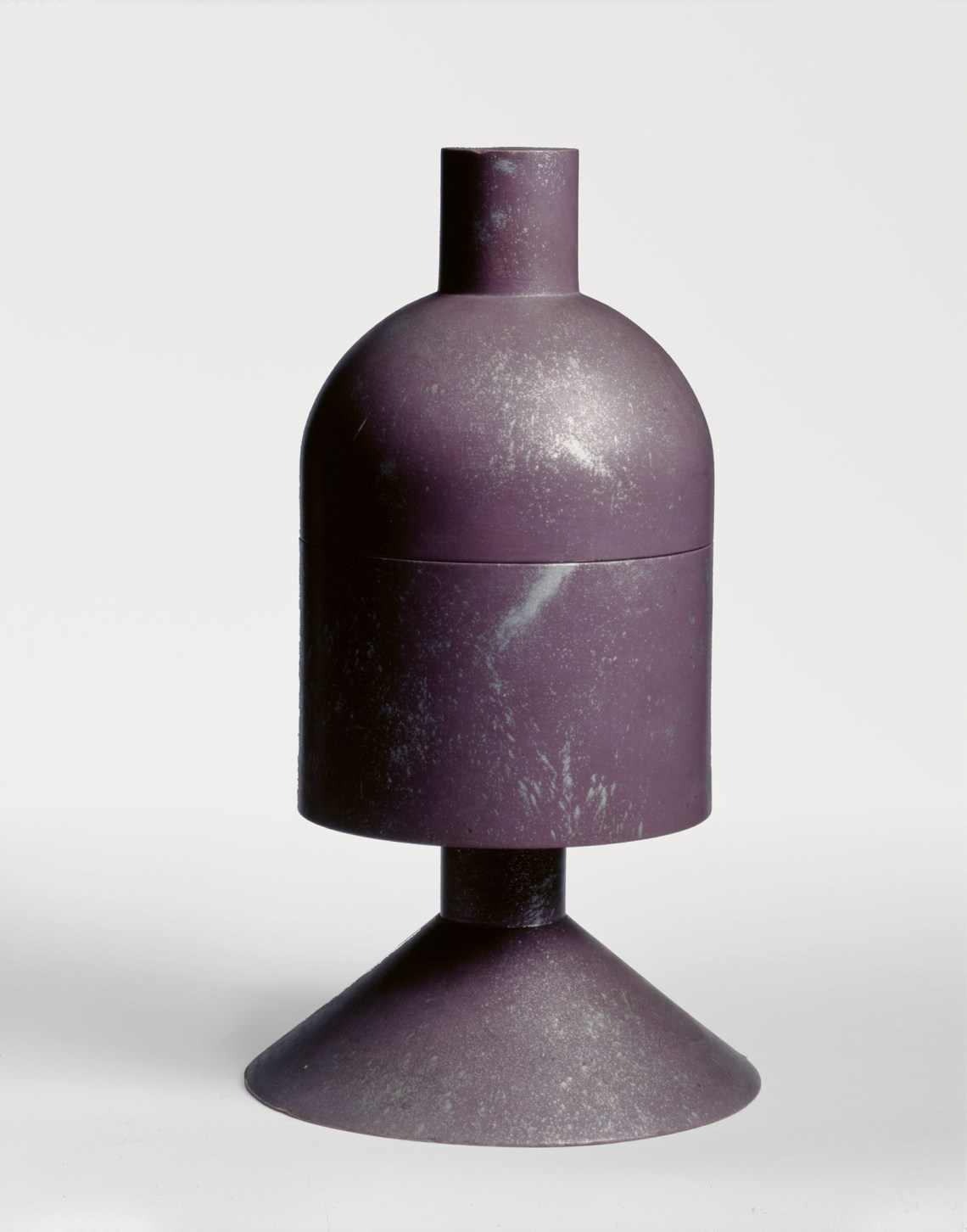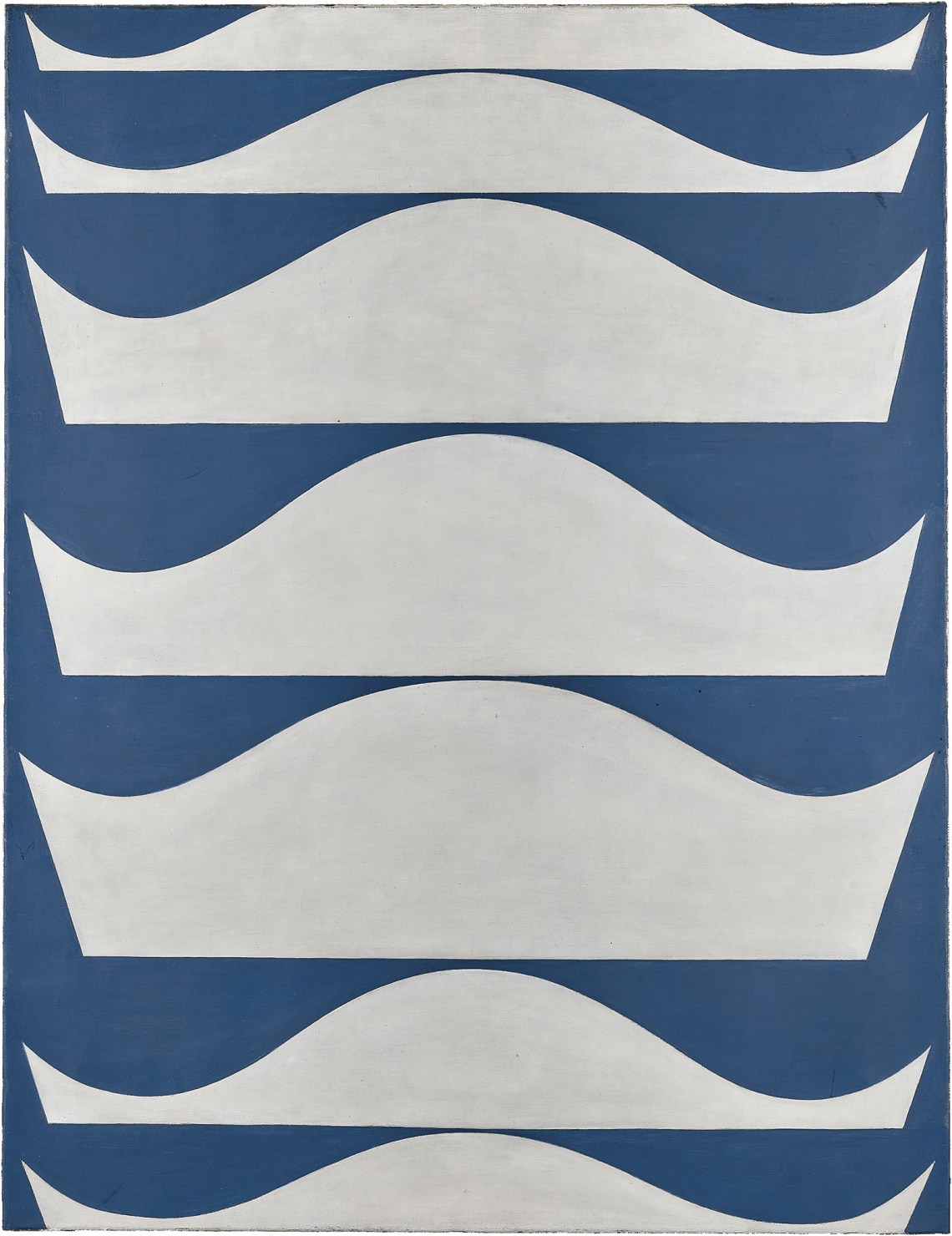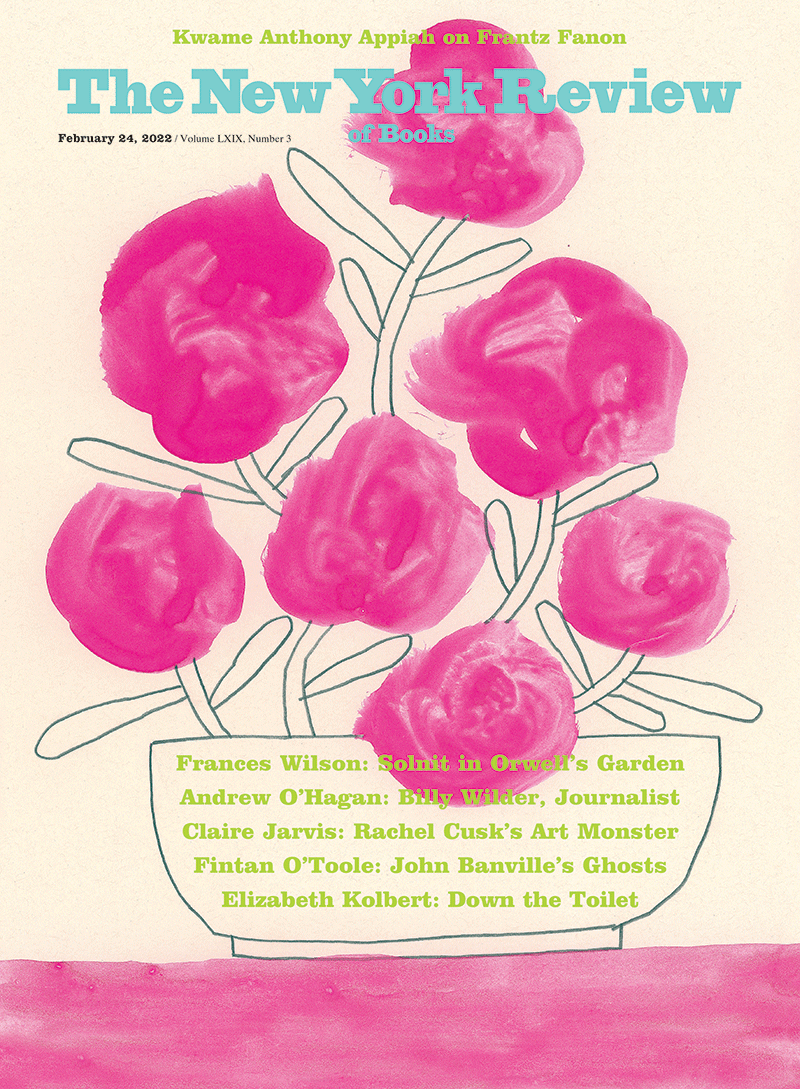Sophie Taeuber-Arp was given a small show at the Museum of Modern Art forty years ago, but the large exhibition there now is the first opportunity for American audiences to have an in-depth look at the Swiss artist, who is probably little more than a name for most viewers. It is a show of some wonderful pieces and, especially from her early years, pictures and objects with a novel mixture of charm and formal strength. Although Taeuber-Arp appears to have been modest and self-effacing, she was, as an artist, fearless. Using a language of abstract forms that easily incorporates references to the human body, say, or animals or trees, she tackled one sort of endeavor after another.
She worked at different times as a painter, a sculptor, and an object maker, and around the time of World War I she created a large and notable ensemble of wood marionettes. It is perhaps the word “puppets” that people first think of in relation to her. Yet she also drew ground plans and elevations for buildings, and the exhibition presents her commissions from the 1920s for stained glass and furniture. Along the way, she created a body of photographs. She wrote on textile design, her field of expertise, and between 1937 and 1939 she was the editor of Plastique/Plastic, an internationally distributed magazine that fostered abstract art. Her accidental death from carbon monoxide poisoning in 1943 came days before her fifty-fourth birthday.
Not all her art remains vibrant. Stretches of it, particularly from the 1930s, feel merely historical. Taeuber-Arp brought an understated polish and finesse to everything she did, but her understatedness makes some of her work come across as simply reflecting its period. Yet it is a boon to get finally a sense of the full scope of her artistry. It is as if a time capsule has been opened. Inserting Taeuber-Arp into the story of twentieth-century art makes us see that art, or at least certain of its milestones, with new eyes.
Taeuber-Arp got underway around 1916, when she was in her mid-twenties, with ostensibly simple yet beguiling abstractions made up of rectangular and curvy units of color. Areas in them that recall the geometries of tribal weavings might be deftly mixed in with forms alluding not only to people or dogs but to buildings or even letters of the alphabet. The pictures range from small to tiny, yet because there is nothing indeterminate about the way she brings her forms together, these pieces, like all the work she went on to do, feel more public in tenor than private or intimate.
Largely based in Zurich and with a background in applied art—she taught design and embroidery in the city’s trade school until she was forty—Taeuber-Arp went on to fashion paintings, pillows, and rugs with embroidered wool, using her same variety of blocky forms. In what are feats of design and handiwork, she employed these forms in creating necklaces and small bags with strung glass beads. Making these delectable objects, T’ai Smith explains in the show’s catalog, involved a complex process that began with plotting out on graphs where each bead would go and ended with a bag “where hundreds of knots hold together hundreds of beads.”
During these years she used the technique of turned wood, in which pieces are formed on a lathe, not carved, to make a number of objects that remain pleasingly strange and uningratiating. They are composed of poles and rounded forms and made to stand sturdily on a table. They look as if they could be parts of machinery. Yet they have titles such as Chalice and Powder Box, adding an element of absurdity and surely reflecting the spirit of Dada, which was based in Zurich (and New York) during the years when the horror and devastation of the fighting in World War I were increasingly apparent. If anything unified the many artists who identified with the Dada spirit, it was revulsion at the way that the warring states were perpetuating the meaningless carnage. Artists sought to counter it with more meaninglessness—with assemblages, performances, paintings, manifestos, sculptural objects, collages, poems, costume balls, and spontaneous events that were meant to be evanescent, discomforting, and, essentially, a thorn in the side of anything institutional, traditional, or predictable.
Sophie Taeuber, as she then was, clearly was drawn into the international movement going on at her doorstep. A student since 1915 of what was called the art of movement, she gave public performances in presumably Dadalike and unmethodical ways two years later. The allure of Dada, with its way of saying that literally any kind of material or method perfectly qualified for the making of an artwork, was surely enhanced for Taeuber by her meeting Hans Arp in 1915 in Zurich. He had also used textiles in some collages, and he was soon to become her lifelong partner (they married in 1922) and a major participant in Dada events. As Anne Umland and Walburga Krupp point out in their fine introduction to the exhibition catalog, Taeuber-Arp thought it important to note in a biographical outline written later in her life that her teaching position at Zurich’s trade school and “her involvement with Dada began simultaneously, in 1916.”
Advertisement
With her seemingly commercial and inartistic technique of turned wood, which she must have known had the capacity to affront some in her audience (and delight others), she created some of her more often reproduced works: little rounded, headlike shapes, which she painted with stylized facial features—one was of Arp—and set on poles. Better known if rarely seen were the marionettes she fashioned in 1918. Her goal was a new way to mount a fairy-tale-like eighteenth-century play by Carlo Gozzi called King Stag. It was put on, with sets and costumes that Taeuber-Arp devised, at the then-new Swiss Marionette Theater. The puppets, which included a bear, a bird, guardsmen, and various magicians and royals—they are splendidly installed at the show, along with a video from a 1993 performance of her production—were also made from turned wood and then painted. Their machinelike origins give them, like her Chalice or Powder Box, an oddly new, and because of this a slightly alienating, quality.
The puppets may be even more distancing in spirit than her Powder Box because, jingling about or collapsed in a heap, they ought to be fairly endearing or lovable. It takes a moment to realize that with their sleek, textureless surfaces, they are a century old. Perhaps they are evincing the aspect of Dada that was meant to grate. On the other hand, the muted, held-in-check note of the puppets, of objects such as Powder Box, and even of Taeuber-Arp’s pictures and necklaces made with wool or glass beads might simply be a product of the applied-art methods that she brought to their creation. With her turned-wood pieces she worked, after all, like a Minimalist sculptor of the 1960s. She laid out the specifications for them on paper, then turned over the job to a technician. Not knowing what her guiding thought was when she created some of her pieces hangs over her art. But it also adds to it an enlivening sense of ambiguity.
For some viewers, the early part of Taeuber-Arp’s work will bring to mind her fellow Swiss artist Paul Klee. Although he was ten years older (and, based in Munich, not connected to Dada), his breakthrough, and perhaps his richest and most mysterious, pictures were created at the time when Taeuber-Arp was making her abstractions, beaded pieces, and puppets. He, too, worked with very small sizes and, as she did, brought a still-resonant life to the interaction of building-block squares, rectangles, triangles, and circles. In the same years, he also made puppets and created sets and theaters for them. Although his creations, made in response to his son’s repeated requests, were hand puppets, not marionettes, he drew faces for them that, like those Taeuber-Arp gave to her multijointed characters, often have large, pronounced eyes and unfriendly demeanors. They are eyes that a child might find scary. They are vaguely unnerving for this adult.
Both artists, moreover, were drawn to a range of subdued, dark tones suffused at times with a feeling for iridescence. Taeuber-Arp achieved this with glass beads and the use of metallic paint, and Klee did it through painting on all sorts of materials. Krupp refers to Taeuber-Arp’s “predilection for reds and purples,” and Klee’s paintings of the time, which bring together checkerboard formats, snippets of images that a child might draw, and rhythmic abstract patterning, sometimes seem to take place in Alpine regions at night. It is as though he were spelling out the moods of a storybook world that she, a less romantic painter-poet, suggests.
In the 1920s Taeuber-Arp moved off in yet another direction. Along with Arp, she worked with her evolving language of geometric forms to redecorate many of the public rooms in a hotel in Strasbourg, where Arp was from. Later they were called on to redo the inside of a Strasbourg entertainment complex called the Aubette. Their designs, both of which featured checkerboards in a variety of ways and look rather elegant in lustrous photographs that were taken at the time, extended through corridors and stairwells and onto ceilings. Along with designing furniture and stained glass for private individuals, Taeuber-Arp also did alterations of other, mostly residential spaces. Although she was not an architect, she drew the plans in 1927 for a studio-residence for herself and her husband in Clamart, outside Paris, and in 1929, along with Marcel-Eugène Cahen, she designed the street façade, the interior, and the furnishings of the Galerie Goemans in Paris.
Advertisement
Taeuber-Arp’s photographs may be even more of a surprise to viewers than her architectural work and furniture. Like Lyonel Feininger and Josef Albers, she saw the medium as another way to extend the spirit of her art. Her diminutive photos of beaches or townscapes, or the Colosseum in Rome, present the play of, for example, open and closed forms (or windows and walls). They are often the same size as her little abstractions of the 1916 period and have much the same combination of casualness and tension. In them, large shadowed areas and walkways and other seemingly “empty” parts of a view become characters in scenes in which the everyday world suddenly appears changed.
In some sense, Taeuber-Arp’s photographs are fresher than her chief works of the 1930s, which are paintings and wall reliefs. Seen in considerable number in the exhibition’s large last room, they juggle dots, straight lines, and boxy forms. Tilting triangles and circular and wavy shapes are also on hand, and everything has been done in a variety of unmodulated colors, with a fair amount of clinical black and white. For me, they are barely distinguishable from the larger realm of twentieth-century geometric abstraction. The effect of these works is that Taeuber-Arp is speaking in a communal language. She seems hardly there.
But beginning in 1934 she made a number of versions of a picture entitled Gradation, in which she took her art into a very different league. It presents an abstract shape that has a resemblance to a stylized clothes hanger or a hat with a little round top and wide brim. It also suggests the top of the Guggenheim Museum, seen from outside, with the building’s round glass ceiling peeping up from the structure’s highest ramp. (Of course, Taeuber-Arp was not thinking of the museum, which did not exist at the time.) In each of her drawn and painted versions of Gradation—there are three in the show and a fourth in the catalog—she has placed a number of examples of the shape, one on top of the next. They are not quite the same in size and outline and are set against a uniform blue or black background. The image is like an open cupboard in which utensils are stacked, except that the shapes do not touch. They hover. They seem to quiver as we look, as her puppets do onstage.
The language of the image is that signal creation of twentieth-century art: the flat shape, often with rounded corners, that frequently suggests something lyrical, erotic, or otherworldly. Taeuber-Arp’s somewhat hatlike shape does not lend itself easily to bodily, literary, or mythical associations. Her picture has, rather, an ethical dimension. It says that these unmoored shapes are independent yet living in the same space or world.
Like a Josef Albers Homage to the Square, Gradation has the quality of an invention, and like a Homage it is a visual demonstration of relativity. The difference is that a Homage is structured with a center square, which can be read as the generating heart of the different colored squares that come from it, or as the end point, the place to which the surrounding colors ultimately return. Taeuber-Arp’s Gradation has no center or sense of an enveloping mystery. For Taeuber-Arp, relativity can be seen in, as it were, the plain light of day.
Gradation puts in focus the way that many of Taeuber-Arp’s pieces, from her early work on, are soft-spoken stories about separate, self-contained elements that take on life as they are balanced against other elements but never blend with any of them. She may have been drawn to making marionettes, for instance, because by definition their bodies are articulated. One of the best works in the show, moreover, a turned-wood sculpture from 1937 entitled Head, presents a personage whose short hair comes to a single point at the top and who appears to have, like a Janus figure, two (big) mouths. Owned by the Yale University Art Gallery, this funny and weird sculpture is one of the few important works by the artist in an American collection.
Taeuber-Arp’s feeling for balance and the equality of separate entities touched her as a person. She and Arp not only worked together in Strasbourg and on certain objects but, by Swiss custom, she affixed her husband’s surname to her own, making her official identity, whether she wanted it or not, a bringing together of equals. A lovely version of this union is embodied in a photograph from the catalog of an exhibition, entitled “Sophie Taeuber,” that opened in 1989 at the Musée d’art moderne de la ville de Paris. It is a seemingly spontaneous snapshot of Sophie, laughing and directly facing, body to body, a subtly smiling Hans, with a bit of landscape between them.
The organizers of the Modern’s show understandably want us to see Taeuber-Arp’s significance as coming less in a stream of discrete masterpieces that head in one direction than in, as Umland and Krupp write, a more “open-ended” way. They see her great variety of concerns as together “challenging distinctions between fine art and craft, major and minor, geometric painting and decoration, precise planning and creativity.” The exhibition’s subtitle, “Living Abstraction,” well encompasses the idea of an achievement that sprawls over conventional boundaries. Taeuber-Arp is indirectly being called, it seems, a performance artist, and to a degree this is accurate.
Certainly, in the photographs of her, especially from her earlier years, ideas about what properly constitutes an artist’s work might be questioned. Whether she dressed herself for a costume ball, appeared at a housewarming party wearing a towering cardboard toque with an inventive three-part cardboard something (a necklace?) around her neck, or was seen by a lake at a clinic in the Alps she had gone to for her health, she is a kind of walking artwork, and one whose message is no different from that of her paintings, sculptures, photographs, or designs for buildings. In her outfits, she presents herself as a whole comprised of a number of equally interesting parts. She has arranged her appearance in such a way that every element—gloves, hat, necklace, belt, whatever—can be noticed for itself.
What has been left out of the exhibition’s concept of Taeuber-Arp’s “open-ended” achievement is any tangible sense of her background. One would think that some sort of commentary was needed on her home life with her mother, Sophie Taeuber-Krüsi, who was seriously involved with textiles and who, in the years after her husband’s death, designed a house for herself and her children and then transformed it to include rooms for student boarders. Surely this subject is as germane as Taeuber-Arp’s involvement with, say, choreography or how she made her bead pieces, each of which has its own small chapter in the catalog.
Missing, too, are photographs, which appear in the 1989 Paris catalog, of Taeuber as a teenager at home. They show how, already around 1903, when she was fourteen or so, she had turned entire walls into large and abstract collages. We see in one photograph a work that, at six or seven feet on a side, is larger than anything in the show. It is a revelation. Against what might be a striped American Indian blanket, she has placed in an unobvious rhythmic order photographs of Indian chiefs or braves. Feathers, a fan, knives, tomahawks, and other items have been affixed at angles. With its vertical stripes, boxy photo displays, and jutting shapes, and its bringing together of disparate entities, the work has in it the unexpectedly balanced geometric scene she would go on to create with many other means.
The wall-size work perhaps also answers the question of how much Taeuber-Arp owed to her professional training in applied-art techniques and to Dada. They were surely both nurturing. They had to have been green lights to her. But the collage on the wall of her home says that, long before these crucial influences, she already knew quite clearly the artwork she wanted to make.
This Issue
February 24, 2022
Liberation Psychology
‘Invitations to Dig Deeper’
Riffraff




